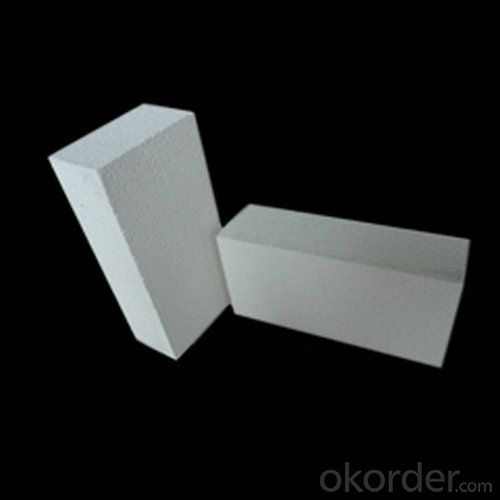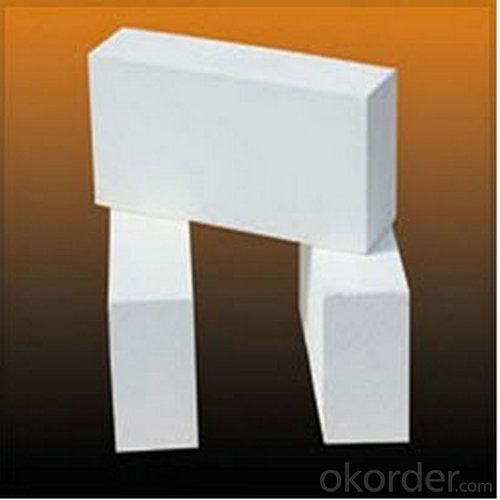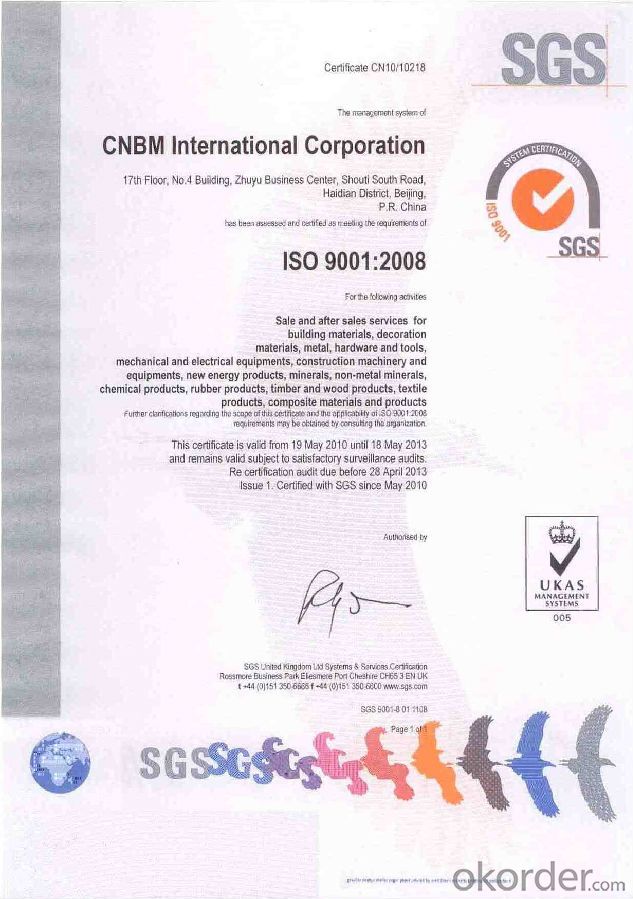Insulating Firebricks GJM23 for hHot Face Lining
- Loading Port:
- Tianjin
- Payment Terms:
- TT OR LC
- Min Order Qty:
- 1 m.t.
- Supply Capability:
- 20000 m.t./month
OKorder Service Pledge
OKorder Financial Service
You Might Also Like
General Information of Insulating Firebricks
CMAX insulating firebricks are classified under temperature between 1300℃ to 1700℃, manufactured from high purity alumina clay.
Feature of Insulating Firebricks
Light weight and low thermal conductivity
Low heat storage
Low iron and impurities
High thermal shock resistance
Application of Insulating Firebricks
CMAX insulating firebricks can be used as a hot face lining directly exposed to the heat or as a backup insulation layer in iron and steel mills, non-ferrous foundries, petrochemical, ceramic, glass.
Images of Insulating Firebricks


Technical Data of Insulating Firebricks
INSULATING FIRE BRICK---GJM23
Classification Temperature (℉/℃) 2300/1260
Bulk Density (g/cm3) ≤0.5
Thermal Conductivity
800℃, W/m.K ≤0.18
1000℃, W/m.K ≤0.20
Reheating Linear Change (%) 1230℃×12h
≤0.5
Chemical Composition (%)
Al2O3 ≥45
Fe2O3 ≤1.0
Company Introduction
Who CNBM is
CNBM is a Fortune 500 and a governmental owned National Building Material company in Beijing, China.
What CNBM Can Do
We can supply ALL KINDS OF REFRACTORIES BRICK/CASTABLE and CERAMIC FIBER PRODUCTS in high quality and competitive price.
What Certification CNBM Have

FAQ
If I need your offer, what information do you need?
In order to choose suitable products, it will be appreciated to provide us the information, such us specification, technical data, order quantity, products application etc.
If any question, please contact us freely.
How do you control the products quality?
With strict quality control system throughout the materials selection and production process, our refractory and ceramic fiber products quality is effectively controlled to meet customer requirements.
From the raw materials selecting, our quality control begin. The quality certificates of raw materials are required and each batch will be tested before using. During production, the quality control are conducted by workers and then each piece will be sorted and examined by quality supervisor.
I’m not satisfied with the refractory materials I used before, can you propose more suitable pro
Yes. Please give us the problems you faced, your requirements and the technical data of the products you used before. That we will give you our suggestion and propose the solution based on your special requirements.
What’s the lead time for my order?
It depends on customers’ requirements and our production schedule. And usually we need 30-60 days for refractory bricks,10-25 days for unshaped refractory materials and 10-20 days for ceramic fiber blankets.
Can you offer Door-to-Door delivery?
Yes, but only for some countries such us U.S., UAE, Saudi Arabia, Iran, and Russia, etc.
What is the minimum quantity?
There is no minimum order quantity. Depending on the item and processing, there may be a minimum production required, however we can offer a quotation based only on the quantity you need.
- Q:Do insulating fire bricks require special installation techniques?
- Yes, insulating fire bricks do require special installation techniques. These bricks are designed to withstand high temperatures and provide insulation, so proper installation is crucial to ensure their effectiveness. Special attention needs to be given to factors such as mortar selection, brick alignment, and proper curing to achieve optimal thermal performance.
- Q:Are insulating fire bricks suitable for use in the construction of smelters?
- Yes, insulating fire bricks are suitable for use in the construction of smelters. Insulating fire bricks are designed to withstand high temperatures and provide excellent insulation properties, making them ideal for applications such as smelters. They have low thermal conductivity, meaning they can effectively retain heat and reduce energy loss during the smelting process. Additionally, insulating fire bricks are resistant to thermal shock, which is crucial in smelting operations where rapid temperature changes are common. Their high heat resistance and insulation capabilities make insulating fire bricks a reliable choice for constructing smelters.
- Q:What is the bulk density of insulating bricks?
- Stoneware porcelain water absorption rate is greater than 0.5% and less than or equal to 3%; fine stoneware bibulous rate is greater than 3% and less than or equal to 6%; brick bibulous rate is greater than 6% and less than or equal to 10%; pottery tile water absorption rate is greater than 10%. The water absorption rate of expression: ceramic brick brick >6% = >10% = >3% = fine stoneware porcelain stoneware or porcelain >0.5%
- Q:Do insulating fire bricks require any maintenance?
- Insulating fire bricks, also known as refractory bricks, have been designed to endure high temperatures and offer exceptional insulation properties. One notable advantage of these bricks is their minimal maintenance requirements. These bricks are crafted from specialized materials that exhibit high heat resistance and are not easily prone to cracking or breaking, thereby reducing the need for frequent repairs or replacements. Nevertheless, similar to other materials, insulating fire bricks may accumulate dust or debris over time. To preserve their effectiveness and extend their lifespan, it is recommended to regularly clean them by employing a soft brush or vacuum cleaner to eliminate any loose particles. Additionally, it is crucial to periodically inspect the bricks for any signs of damage, such as cracks or erosion. Promptly addressing any identified issues is vital to prevent further deterioration. In summary, although insulating fire bricks do not demand extensive upkeep, regular cleaning and inspection are essential to ensure their optimal performance and longevity.
- Q:Can insulating fire bricks be used for insulation in steel mills?
- Yes, insulating fire bricks can be used for insulation in steel mills. Insulating fire bricks are specifically designed to withstand high temperatures and are used in various industrial applications, including steel mills, to provide thermal insulation and reduce heat loss. They help maintain consistent temperatures, improve energy efficiency, and protect equipment and structures from extreme heat.
- Q:Are insulating fire bricks resistant to gas permeability?
- Yes, insulating fire bricks are resistant to gas permeability. They have low porosity and high density, which prevents the penetration of gases, making them an effective barrier against gas permeation.
- Q:What is the typical lifespan of insulating fire bricks in high-temperature applications?
- The typical lifespan of insulating fire bricks in high-temperature applications can vary depending on several factors. These factors include the quality and composition of the bricks, the specific temperatures they are exposed to, the rate of thermal cycling, and any other external factors that may impact their durability. Generally, insulating fire bricks are designed to withstand high temperatures and have a longer lifespan compared to regular bricks or other materials. They are typically made from lightweight refractory materials, such as alumina and silica, which have excellent thermal insulating properties. In high-temperature applications, insulating fire bricks can typically last for several years, even decades, when properly installed and maintained. However, it is important to note that continuous exposure to extremely high temperatures, rapid temperature changes, or harsh chemical environments can accelerate the wear and tear of these bricks. Regular inspection and maintenance of insulating fire bricks are crucial to ensure their longevity. Over time, these bricks may experience thermal shock, erosion, or cracking due to the extreme thermal conditions. By identifying any signs of degradation or damage early on, appropriate measures can be taken to repair or replace the affected bricks, thus extending the overall lifespan of the insulation system. Ultimately, the specific lifespan of insulating fire bricks in high-temperature applications can vary greatly and is influenced by various factors. Therefore, it is recommended to consult with manufacturers or industry experts who can provide more accurate estimations based on the specific conditions of your application.
- Q:Can insulating fire bricks be used in brick kilns?
- Yes, insulating fire bricks can be used in brick kilns. Insulating fire bricks are designed to have high thermal resistance, which makes them an ideal choice for insulating the walls of a brick kiln. These bricks can withstand extremely high temperatures and help to maintain consistent heat levels within the kiln. By using insulating fire bricks, the heat loss from the kiln is minimized, resulting in improved energy efficiency and reduced fuel consumption. Additionally, the use of insulating fire bricks can also help to protect the outer layers of the kiln from excessive heat, preventing damage and prolonging the lifespan of the kiln. Overall, insulating fire bricks are a suitable and effective choice for use in brick kilns.
- Q:Can insulating fire bricks be used in smelting furnaces?
- Yes, insulating fire bricks can be used in smelting furnaces. Insulating fire bricks are designed to have low thermal conductivity, which helps to conserve heat and maintain high temperatures inside the furnace. This makes them an ideal choice for smelting furnaces where high temperatures are required. Additionally, insulating fire bricks also have a high resistance to thermal shock, which means they can withstand rapid temperature changes without cracking or breaking. This is particularly important in smelting furnaces where the temperature can fluctuate significantly. Overall, insulating fire bricks are an excellent option for smelting furnaces as they help to improve energy efficiency, reduce heat loss, and provide durability in high-temperature environments.
- Q:Are insulating fire bricks resistant to metal penetration?
- Yes, insulating fire bricks are resistant to metal penetration. These bricks are designed to have low thermal conductivity and high refractoriness, making them an effective barrier against the penetration of molten metal.
1. Manufacturer Overview |
|
|---|---|
| Location | |
| Year Established | |
| Annual Output Value | |
| Main Markets | |
| Company Certifications | |
2. Manufacturer Certificates |
|
|---|---|
| a) Certification Name | |
| Range | |
| Reference | |
| Validity Period | |
3. Manufacturer Capability |
|
|---|---|
| a)Trade Capacity | |
| Nearest Port | |
| Export Percentage | |
| No.of Employees in Trade Department | |
| Language Spoken: | |
| b)Factory Information | |
| Factory Size: | |
| No. of Production Lines | |
| Contract Manufacturing | |
| Product Price Range | |
Send your message to us
Insulating Firebricks GJM23 for hHot Face Lining
- Loading Port:
- Tianjin
- Payment Terms:
- TT OR LC
- Min Order Qty:
- 1 m.t.
- Supply Capability:
- 20000 m.t./month
OKorder Service Pledge
OKorder Financial Service
Similar products
New products
Hot products
Related keywords





























